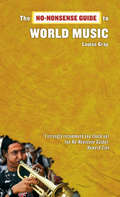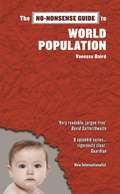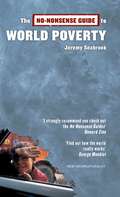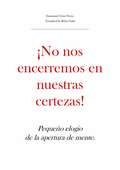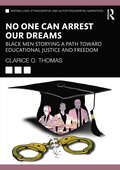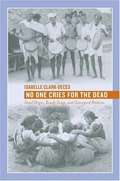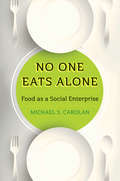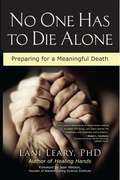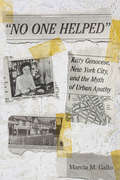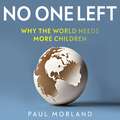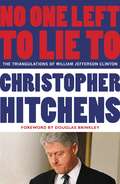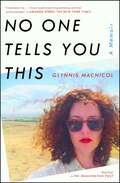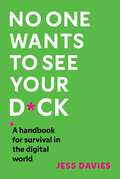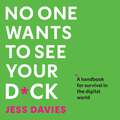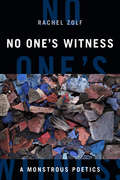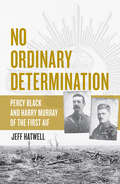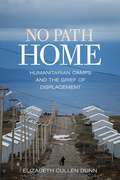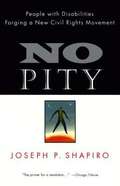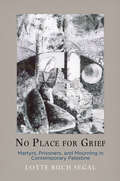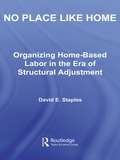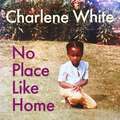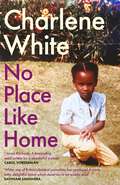- Table View
- List View
No-Nonsense Guide to World Music (No-Nonsense Guides #31)
by Louise Gray“World music” is an awkward phrase. Used to describe the hugely multifaceted nature of a range of, typically, non-English language popular musics from the world over, it’s a tag that throws up as many problems as it does solutions. Louise Gray’s No-Nonsense Guide to World Music attempts to go behind the phrase to explore the reasons for the contemporary interest in world music: who listens to it and why? Through chapters that focus on specific areas of music, such as rembetika, fado, trance music and new folk, it explores the genres that have emerged from marginalized communities, music from conflict zones, and music as a form of escapism.
The No-Nonsense Guide to World Population
by Vanessa BairdNo-Nonsense Guide to World Population (1/2 page) With world population passing seven billion and predicted to hit nine billion by 2050, we are in the grip of a number panic. This book explodes some of the common myths, looks at what the numbers really mean, and addresses nine topics, such as why women in most parts of the world have fewer children, what will happen to our societies as we all live longer, and how having babies relates to climate change. Vanessa Baird is co-editor at New Internationalist magazine. Her previous books include The No-Nonsense Guide to Sexual Diversity and, as compiler and editor, Eye to Eye Women.
The No-Nonsense Guide to World Poverty
by Jeremy SeabrookThis guide questions conventional thinking about wealth and poverty--is the opposite of poverty really wealth, or is it safety and sufficiency?Drawing on experience of poor people all over the world, the author gives voice to those whose views are rarely sought and shows how we all need to live more modestly to make poverty history. Jeremy Seabrook has written more than thirty books (including Travels in the Skin Trade and Children of Other Worlds), and has worked as a teacher, social worker, journalist, lecturer, and playwright. He has contributed to many magazines, including the New Statesman and The Ecologist.
¡No nos encerremos en nuestras certezas! Pequeño elogio de la apertura de mente
by Emmanuel Terre-Neuve Belén GalánTener una mente abierta no es tan fácil cuando vivimos en una sociedad saturada de divisiones, deteriorada por las tensiones, los prejuicios e incomprensiones. Nos encontramos con muchas dificultades para lograr hacer de nuestra diversidad una riqueza. El objetivo de este pequeño libro no es dar lecciones de filosofía o ética, sino proponer un listado de herramientas que quizás nos permitan no dejarnos llevar tanto por nuestras certezas y ser más tolerantes. La apertura de mente no se decreta, se trabaja. ¡Pongámonos a ello!
No One Can Arrest Our Dreams: Black Men Storying a Path Toward Educational Justice and Freedom (ISSN)
by Clarice O. ThomasA narrative inquiry into the lives of three men, Robert, Raheem, and Warren, this book shares their stories about over-discipline in school, adverse teacher-student relationships, and violent community policing that proceeded and intersected with their involvement in the criminal justice system. After being incarcerated, the men restored their dreams through the same structure that helped remove them from society—the education system.This book critically analyzes the school policies and individual practices that inflict educational harm upon the lives of students who experience criminalization, disengagement, and lack connectedness and a sense of belonging at school. The narratives center the voices of three men who describe how home environments and educational policies and practices structure schools into locations where Black and other minoritized students are forced to survive. Their stories help examine how criminalized experiences—school removal and incarceration—intersect with historical and social factors that create anti-Black practices in schools and communities. These narrative accounts are critical pedagogical tools for those who work with Black, Latinx, low-income, and other minoritized youth. Readers will have a more in-depth understanding about how Black males experience schools, neighborhoods, and the world.This volume will appeal to teachers and teacher educators in K-12 schools, colleges, and universities. More specifically, faculty in programs that lead to elementary, middle, and secondary education certifications can incorporate the stories into courses around cultural diversity, equity and inclusion, social justice, and humanizing pedagogies. Community organizations can use the narrative accounts to create spaces for transformative conversations that aim to improve school and community policing practices.
No One Cries for the Dead: Tamil Dirges, Rowdy Songs, and Graveyard Petitions
by Isabelle Clark-DecèsAt South Indian village funerals, women cry and lament, men drink and laugh, and untouchables sing and joke to the beat of their drums. No One Cries for the Dead offers an original interpretation of these behaviors, which seem almost unrelated to the dead and to the funeral event. Isabelle Clark-Dece's demonstrates that rather than mourn the dead, these Tamil funeral songs first and foremost give meaning to the caste, gender, and personal experiences of the performers.
No One Eats Alone: Food as a Social Enterprise
by Michael S. CarolanIn today's fast-paced, fast food world, everyone seems to be eating alone, all the time—whether it's at their desks or in the car. Michael Carolan argues that needs to change if we want healthy, equitable, and sustainable food. We can no longer afford to ignore human connections as we struggle with dire problems like hunger, obesity, toxic pesticides, antibiotic resistance, depressed rural economies, and low-wage labor. In No One Eats Alone he tells the stories of people getting together to change their relationship to food and to each other—from community farms where suburban moms and immigrant families work side by side, to online exchanges where entrepreneurs share kitchen space, to "hackers” who trade information about farm machinery repairs. This is how real change happens, Carolan contends: when we start acting like citizens first and consumers second.
No One Has to Die Alone
by Lani Leary Jean WatsonCaring for a terminally ill loved one can be the single biggest challenge of your life. Drawing from her experience sitting with over 500 people as they died and caring for her own terminally ill father, Dr. Lani Leary gently guides caregivers, family, and friends through the difficult transitions of illness, death, and bereavement. No One Has to Die Alone offers the practical skills, vocabulary, and insights needed to truly address the needs of a dying loved one while caring for yourself through the process. Dr. Leary shows both patient and caregiver how to rise above feelings of fear and isolation to find peace and meaning in each person's unique end-of-life experience. Whether used as a reference book to address a particular challenge or read from start to finish, this is a must-read for anyone facing death or the loss of a loved one. You'll learn: * how to listen to and support a loved one's needs; * what to expect as a loved one declines and the different grieving processes and tasks; * the key to supporting a grieving child; * what resources are available for patients and caregivers; * the lessons of near-death experiences and the value of after-death communications.
"No One Helped": Kitty Genovese, New York City, and the Myth of Urban Apathy
by Marcia M. GalloIn "No One Helped" Marcia M. Gallo examines one of America's most infamous true-crime stories: the 1964 rape and murder of Catherine "Kitty" Genovese in a middle-class neighborhood of Queens, New York. Front-page reports in the New York Times incorrectly identified thirty-eight indifferent witnesses to the crime, fueling fears of apathy and urban decay. Genovese's life, including her lesbian relationship, also was obscured in media accounts of the crime. Fifty years later, the story of Kitty Genovese continues to circulate in popular culture. Although it is now widely known that there were far fewer actual witnesses to the crime than was reported in 1964, the moral of the story continues to be urban apathy. "No One Helped" traces the Genovese story's development and resilience while challenging the myth it created. "No One Helped" places the conscious creation and promotion of the Genovese story within a changing urban environment. Gallo reviews New York's shifting racial and economic demographics and explores post-World War II examinations of conscience regarding the horrors of Nazism. These were important factors in the uncritical acceptance of the story by most media, political leaders, and the public despite repeated protests from Genovese's Kew Gardens neighbors at their inaccurate portrayal. The crime led to advances in criminal justice and psychology, such as the development of the 911 emergency system and numerous studies of bystander behaviors. Gallo emphasizes that the response to the crime also led to increased community organizing as well as feminist campaigns against sexual violence. Even though the particulars of the sad story of her death were distorted, Kitty Genovese left an enduring legacy of positive changes to the urban environment.
No One Left: Why the World Needs More Children
by Paul MorlandA population calamity is unfolding before our eyes. It started in parts of the developed world and is spreading to the four corners of the globe. There are just too few babies being born for humanity to replace itself.Leading demographer Paul Morland argues that the consequences of this promise to be calamitous. Labour shortages, pensions crises, ballooning debt: what is currently happening in South Korea - which faces population decline of more than 85% within just two generations - threatens to engulf us all, and sooner than we think. In the developed world we may be able temporarily to stave off the worst of its effects with immigration, but many countries, including those the immigrants come from, will get old before they get rich.No One Left charts this future, explains its causes and suggests what might be done. Unless we radically change our attitudes towards parenthood and embrace a new progressive pro-natalism, argues Morland, we face disaster.
No One Left to Lie To: The Triangulations of William Jefferson Clinton
by Douglas Brinkley Christopher Hitchens"Just as the necessary qualification for a good liar is a good memory, so the essential equipment of a would-be lie detector is a good timeline, and a decent archive." In NO ONE LEFT TO LIE TO, a New York Times bestseller, Christopher Hitchens casts an unflinching eye on the Clinton political machine and offers a searing indictment of a president who sought to hold power at any cost. With blistering wit and meticulous documentation, Hitchens masterfully deconstructs Clinton's abject propensity for pandering to the Left while delivering to the Right, and he argues that the president's personal transgressions were ultimately inseparable from his political corruption. Hitchens questions the president's refusals to deny accusations of rape by reputable women and lambasts, among numerous impostures, his insistence on playing the race card, the shortsightedness of his welfare bill, his ludicrous war on drugs, and his abandonment of homosexuals in the form of the Defense of Marriage Act. Opportunistic statecraft, crony capitalism, "divide and rule" identity politics, and populist manipulations-these are perhaps Clinton's greatest and most enduring legacies.
No One Tells You This: A Memoir
by Glynnis MacNicolSelected as one of BuzzFeed’s “Exciting Summer Books” Featured in Goop's “15 Books We’re Reading This Summer” Selected as one of Vogue’s “13 Books to Thrill, Entertain, and Sustain You This Summer” Selected as one of Bustle's “15 Best Nonfiction Books Coming Out In July 2018” If the story doesn’t end with marriage or a child, what then?This question plagued Glynnis MacNicol on the eve of her 40th birthday. Despite a successful career as a writer, and an exciting life in New York City, Glynnis was constantly reminded she had neither of the things the world expected of a woman her age: a partner or a baby. She knew she was supposed to feel bad about this. After all, single women and those without children are often seen as objects of pity, relegated to the sidelines, or indulgent spoiled creatures who think only of themselves. Glynnis refused to be cast into either of those roles and yet the question remained: What now? There was no good blueprint for how to be a woman alone in the world. She concluded it was time to create one. Over the course of her fortieth year, which this memoir chronicles, Glynnis embarks on a revealing journey of self-discovery that continually contradicts everything she’d been led to expect. Through the trials of family illness and turmoil, and the thrills of far-flung travel and adventures with men, young and old (and sometimes wearing cowboy hats), she is forced to wrestle with her biggest hopes and fears about love, death, sex, friendship, and loneliness. In doing so, she discovers that holding the power to determine her own fate requires a resilience and courage that no one talks about, and is more rewarding than anyone imagines. Intimate and timely, No One Tells You This is a fearless reckoning with modern womanhood and an exhilarating adventure that will resonate with anyone determined to live by their own rules.
No One Wants to See Your D*ck: A Handbook for Survival in the Digital World
by Jess DaviesAre women asking for it because of their outfits, routes home, profile pictures or social media posts? Or we can we finally admit that there might be something wrong with masculinity in the digital world?The rising popularity of misogynistic content and toxic masculinity influencers combined with a lack of regulation within social media has created a perfect storm. Our increasingly online world has opened women and young girls up to a whole new level of violence that follows them into their homes, schools and workplaces.In No One Wants to See Your D*ck women's rights campaigner Jess Davies reveals the shocking realities of this epidemic and what we can do to stop it. Covering everything from cyberflashing and deepfakes to the manosphere and catfishing, Jess offers practical advice and accessible language to help you understand what is happening online, what to do if you become a victim of it and why drastic change is needed now. Urgent and eye-opening, this is a vital toolkit for understanding and putting an end to violence against women.
No One Wants to See Your D*ck: A Handbook for Survival in the Digital World
by Jess DaviesAre women asking for it because of their outfits, routes home, profile pictures or social media posts? Or we can we finally admit that there might be something wrong with masculinity in the digital world?The rising popularity of misogynistic content and toxic masculinity influencers combined with a lack of regulation within social media has created a perfect storm. Our increasingly online world has opened women and young girls up to a whole new level of violence that follows them into their homes, schools and workplaces.In No One Wants to See Your D*ck, women's rights campaigner Jess Davies reveals the shocking realities of this epidemic and what we can do to stop it. Covering everything from cyberflashing and deepfakes to the manosphere and catfishing, Jess offers practical advice and accessible language to help you understand what is happening online, what to do if you become a victim of it and why drastic change is needed now. Urgent and eye-opening, this is a vital toolkit for understanding and putting an end to violence against women.
No One Will Let Her Live
by Claire Snell-RoodThe inequalities that structure relationships in Delhi's urban slums have left the health of women living there chronically vulnerable. Yet for women living in slums, there is no other option than to depend on someone. Based on fourteen months of intensive fieldwork with ten families in a Delhi slum, No One Will Let Her Live argues that women rely on moral strategies to confront the poverty and unstable relationships that threaten their well-being. Claire Snell-Rood breaks new ground by delineating the complex ways in which women set boundaries, maintain their independence, and develop a nuanced sense of selfhood that draws on endurance, asceticism, mobility, and citizenship.
No One's Witness: A Monstrous Poetics (Black Outdoors: Innovations in the Poetics of Study)
by Rachel ZolfIn No One's Witness Rachel Zolf activates the last three lines of a poem by Jewish Nazi holocaust survivor Paul Celan—“No one / bears witness for the / witness”—to theorize the poetics and im/possibility of witnessing. Drawing on black studies, continental philosophy, queer theory, experimental poetics, and work by several writers and artists, Zolf asks what it means to witness from the excessive, incalculable position of No One. In a fragmentary and recursive style that enacts the monstrous speech it pursues, No One's Witness demonstrates the necessity of confronting the Nazi holocaust in relation to transatlantic slavery and its afterlives. Thinking along with black feminist theory's notions of entangled swarm, field, plenum, chorus, No One's Witness interrogates the limits and thresholds of witnessing, its dangerous perhaps. No One operates outside the bounds of the sovereign individual, hauntologically informed by the fleshly no-thingness that has been historically ascribed to blackness and that blackness enacts within, apposite to, and beyond the No One. No One bears witness to becomings beyond comprehension, making and unmaking monstrous forms of entangled future anterior life.
No Ordinary Determination: Percy Black and Harry Murray of the First AIF
by Jeff HatwellAn epic tale of two ordinary individuals thrown into theextraordinary and surreal world of the Gallipoli campaignas soldiers of the First AIF in WWI.Percy Black and Harry Murray were plain hard-workingAustralians whose paths crossed in Western Australiawhen they enlisted in support of country and empire. Thepowerful narrative paints a complex and thorough pictureof the heroism, loyalty, inventiveness, mateship, stoicismand strength of the many individuals, on all sides, caughtup in the horror of the ‘war to end all wars’.
No Path Home: Humanitarian Camps and the Grief of Displacement
by Elizabeth Cullen DunnFor more than 60 million displaced people around the world, humanitarian aid has become a chronic condition. No Path Home describes its symptoms in detail. Elizabeth Cullen Dunn shows how war creates a deeply damaged world in which the structures that allow people to occupy social roles, constitute economic value, preserve bodily integrity, and engage in meaningful daily practice have been blown apart. After the Georgian war with Russia in 2008, Dunn spent sixteen months immersed in the everyday lives of the 28,000 people placed in thirty-six resettlement camps by official and nongovernmental organizations acting in concert with the Georgian government. She reached the conclusion that the humanitarian condition poses a survival problem that is not only biological but also existential. In No Path Home, she paints a moving picture of the ways in which humanitarianism leaves displaced people in limbo, neither in a state of emergency nor able to act as normal citizens in the country where they reside.
No Pity: People with Disabilities Forging a New Civil Rights Movement
by Joseph P. ShapiroPeople with disabilities forging the newest and last human rights movement of the century.
No Place For Dying: Hospitals and the Ideology of Rescue
by Helen Stanton ChappleThe U.S. hospital embodies society’s hope for itself—a technological bastion standing between us and death. What does the gold standard of rescue, as ideology and industry, mean for the dying patient in the hospital and for the status of dying in American culture? This book shows how dying is a management problem for hospitals, occupying space but few billable encounters and of little interest to medical practice or quality control. An anthropologist and bioethicist with two decades of professional nursing experience, Helen Chapple goes beyond current work on hospital care to present fine-grained accounts of the clinicians, patients, and families who navigate this uncharted, untidy, and unpredictable territory between the highly choreographed project of rescue and the clinical culmination of death. This book and its important social and policy implications make key contributions to the social science of medicine, nursing, hospital administration, and health care delivery fields.
No Place for Grief: Martyrs, Prisoners, and Mourning in Contemporary Palestine (The Ethnography of Political Violence)
by Lotte Buch SegalWesterners 'know' Palestine through images of war and people in immediate distress. Yet this focus has as its consequence that other, less spectacular stories of daily distress are rarely told. Those seldom noticed are the women behind the men who engage in armed resistance against the military occupation: wives of the Palestinian prisoners in Israeli detention and the widows of the martyrs. In Palestine, being related to a detainee serving a sentence for participation in the resistance activities against Israel is a source of pride. Consequently, the wives of detainees are expected to sustain these relationships through steadfast endurance, no matter the effects upon the marriage or family. Often people, media, and academic studies address the dramatic violence and direct affliction of the Palestinians. Lotte Buch Segal takes a different approach, and offers a glimpse of the lives, and the contradictory emotions, of the families of both detainees and martyrs through an in-depth ethnographic investigation.No Place for Grief asks us to think about what it means to grieve when that which is grieved does not lend itself to a language of loss and mourning. What does it mean to "endure" when ordinary life is engulfed by the emotional labor required to withstand the pressures placed on Palestinian families by sustained imprisonment and bereavement? Despite an elaborate repertoire of narrative styles, laments, poetry, and performance of bodily gestures through which mourning can be articulated, including the mourning tied to a political cause, Buch Segal contends that these forms of expression are inadequate to the sorrow endured by detainees' wives. No Place for Grief reveals a new language that describes the entanglement of absence and intimacy, endurance and everyday life, and advances an understanding of loss, mourning, and grief in contemporary Palestine.
No Place Left to Bury the Dead
by Nicole ItanoEVERY DAY in Africa, approximately 7,000 men, women, and children are erased from the face of this planet by the devastating AIDS virus that -- even after more than two and a half decades -- continues to wreak havoc around the globe, especially in underdeveloped nations. No Place Left to Bury the Dead dares to go where media, governments, and ordinary individuals in the West seldom venture -- face-to-face with fellow humans suffering in the shadow of our collective ignorance and neglect. In this haunting investigation, acclaimed journalist Nicole Itano goes beyond traditional journalistic methods as she eats, sleeps, and lives with the women who struggle daily with the raging epidemic of AIDS. Working from the personal accounts of a few real women living with the disease, Itano traces their moments of discovery and diagnosis, their first symptoms, and the ways they cope with treatment and manage the news with their families. Itano's masterful blend of the personal, scientific, and historical turns statistics into stories and balances tragedy with hope as she outlines the scope of new treatment and prevention. In a time when celebrity and political heavy hitters such as Bono and Bill Clinton are rushing to find a remedy for Africa's increasing problem, No Place Left to Bury the Dead shows the world how the transformation of a few courageous women can heal entire communities and eradicate denial, and how books like these increase global awareness of one of the worst epidemics in human history. Like And the Band Played On and The Coming Plague, this book is a wake-up call that is urgently needed.
No Place Like Home: Organizing Home-Based Labor in the Era of Structural Adjustment (New Approaches in Sociology)
by David StaplesNo Place Like Home examines the emergence of home-based women workers as paradigmatic figures of contemporary capitalism, neoliberal governmentality, and socio-political contestation. Far from an isolated or contingent situation, home-based work constitutes today an enormous arena of 'invisible' social and political struggles of subaltern and ethno-racially subordinated women.
No Place Like Home: ‘A universal message … Warm, witty and delightful’ SATHNAM SANGHERA
by Charlene White'White, one of Britain's boldest journalists, has produced a warm, witty, delightful memoir which deserves to be widely read' Sathnam Sanghera, author of Empireland'I loved this book. A fascinating read written by a wonderful woman' Carol Vorderman'To feel as though you belong and knowing who you are are both the most important necessities of life and essential to one's wellbeing. This historic, inspirational book demonstrates that' Baroness Floella Benjamin, OM DBEHome is a vital base for us to thrive, yet, for some, the question of where home is isn't as simple as an address.Depending on circumstance, 'home' may not simply be where we rest, eat and sleep. With the concept of home comes questions of ancestry, identity and belonging, and the understanding that there is no one fixed idea of what or where home is.In No Place Like Home, Charlene White boldly shares her own story and understanding of home as a Jamaican Londoner exploring all the smells, memories and voices from her childhood. Alongside her personal story, White interviews eight individuals who give their perspectives on home and their experiences that are shaped by myriad events from difficult family situations to desperate political upheaval and war. No Place Like Home is a powerful and heartfelt exploration of family, food and finding your place, as well as the moments in history that have changed the way we feel about the simplest of terms: 'home'.
No Place Like Home: ‘A universal message … Warm, witty and delightful’ SATHNAM SANGHERA
by Charlene White'White, one of Britain's boldest journalists, has produced a warm, witty, delightful memoir which deserves to be widely read' Sathnam Sanghera, author of Empireland'I loved this book. A fascinating read written by a wonderful woman' Carol Vorderman'To feel as though you belong and knowing who you are are both the most important necessities of life and essential to one's wellbeing. This historic, inspirational book demonstrates that' Baroness Floella Benjamin, OM DBEHome is a vital base for us to thrive, yet, for some, the question of where home is isn't as simple as an address.Depending on circumstance, 'home' may not simply be where we rest, eat and sleep. With the concept of home comes questions of ancestry, identity and belonging, and the understanding that there is no one fixed idea of what or where home is.In No Place Like Home, Charlene White boldly shares her own story and understanding of home as a Jamaican Londoner exploring all the smells, memories and voices from her childhood. Alongside her personal story, White interviews eight individuals who give their perspectives on home and their experiences that are shaped by myriad events from difficult family situations to desperate political upheaval and war. No Place Like Home is a powerful and heartfelt exploration of family, food and finding your place, as well as the moments in history that have changed the way we feel about the simplest of terms: 'home'.
